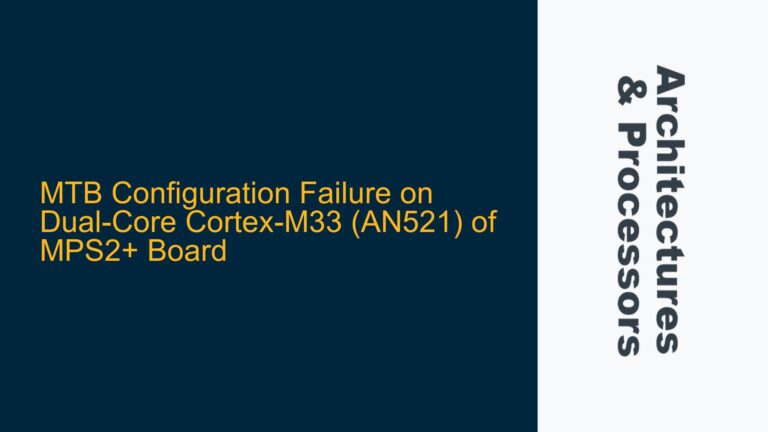FPU Version Variability Across ARM Cortex-M Microcontrollers
The Floating-Point Unit (FPU) is a critical component in ARM Cortex-M microcontrollers, enabling efficient handling of floating-point operations. However, the FPU version can vary significantly across different Cortex-M cores and microcontroller families, such as the Tiva C Launchpad (TM4C123GH6PM), STM32F407, and STM32F446RE. This variability often leads to confusion among developers, especially when configuring toolchains or optimizing firmware for specific FPU capabilities. The FPU version is typically denoted by a specific nomenclature, such as "fpv4-sp-d16," which indicates the architecture, single-precision support, and the number of dedicated registers. Understanding the FPU version is essential for ensuring compatibility with compiler flags, libraries, and application code.
The FPU version is not always explicitly stated in microcontroller datasheets or user manuals, which can make it challenging to identify the correct configuration for a given device. For instance, the Tiva C Launchpad uses the "fpv4-sp-d16" FPU, but this information is not always readily available in the product documentation. Similarly, the STM32F407 and STM32F446RE microcontrollers may have different FPU versions, even though they belong to the same Cortex-M4 family. This variability necessitates a systematic approach to identifying and verifying the FPU version for each microcontroller.
Core Manuals and Documentation as Primary Sources
The most reliable source for identifying the FPU version in ARM Cortex-M microcontrollers is the core technical reference manual provided by ARM. These manuals, such as the ARM Cortex-M4 Technical Reference Manual, contain detailed information about the FPU architecture, including its version, supported features, and register configurations. For example, the Cortex-M4 manual specifies that the FPU version is "fpv4-sp-d16," which indicates a single-precision FPU with 16 dedicated 64-bit registers. This information is crucial for developers who need to configure their toolchains and ensure that their firmware is optimized for the specific FPU capabilities of their target microcontroller.
In addition to the core manuals, microcontroller vendors often provide supplementary documentation that includes details about the FPU. For instance, STMicroelectronics provides reference manuals for their STM32 series microcontrollers, which may include information about the FPU version and its integration with the Cortex-M core. However, these documents may not always explicitly state the FPU version, requiring developers to cross-reference the information with the ARM core manuals. This process can be time-consuming but is necessary to ensure accurate configuration and optimization of the FPU.
Toolchain Configuration and FPU Version Verification
Once the FPU version has been identified, the next step is to configure the toolchain to utilize the FPU effectively. This involves setting the appropriate compiler flags, such as "-mfpu=fpv4-sp-d16" for the Cortex-M4 FPU, and ensuring that the application code is compiled with the correct floating-point ABI (Application Binary Interface). The ARM-none-eabi-gcc toolchain, for example, provides the "–print-multi-lib" option, which lists the supported architectures and ABIs but does not explicitly mention the FPU version. Developers must manually verify the FPU version and configure the toolchain accordingly.
To verify the FPU version, developers can use a combination of methods, including inspecting the microcontroller’s register map, analyzing the disassembled code, and running diagnostic tests. For instance, the CPACR (Coprocessor Access Control Register) in the Cortex-M4 core can be examined to determine if the FPU is enabled and configured correctly. Additionally, developers can write test code that performs floating-point operations and compares the results with expected values to ensure that the FPU is functioning as intended. This step-by-step verification process is essential for identifying any discrepancies between the expected and actual FPU behavior.
Implementing FPU-Specific Optimizations and Best Practices
After verifying the FPU version and configuring the toolchain, developers can implement FPU-specific optimizations to maximize performance and efficiency. This includes leveraging the FPU’s dedicated registers for floating-point operations, minimizing the use of software emulation for floating-point calculations, and optimizing the memory layout to reduce latency. For example, the Cortex-M4 FPU’s 16 dedicated 64-bit registers can be used to store intermediate results, reducing the need for frequent memory accesses and improving overall performance.
In addition to hardware optimizations, developers should also consider software best practices when working with the FPU. This includes using appropriate data types for floating-point variables, avoiding unnecessary type conversions, and ensuring that the FPU is enabled and configured correctly at runtime. For instance, the FPU must be explicitly enabled in the system initialization code by setting the appropriate bits in the CPACR register. Failure to do so can result in the FPU being disabled, leading to unexpected behavior and performance degradation.
Debugging and Resolving FPU-Related Issues
Despite careful configuration and optimization, developers may encounter issues related to the FPU, such as incorrect floating-point calculations, performance bottlenecks, or unexpected behavior. These issues can often be traced back to misconfigurations in the toolchain, incorrect FPU settings, or bugs in the application code. To debug these issues, developers can use a combination of hardware debugging tools, such as JTAG probes, and software debugging techniques, such as logging and breakpoints.
For example, if floating-point calculations are producing incorrect results, developers can inspect the FPU registers and compare them with the expected values. This can help identify issues such as incorrect data types, improper rounding, or misaligned memory accesses. Additionally, developers can use performance profiling tools to identify bottlenecks in the floating-point code and optimize it accordingly. This iterative debugging process is essential for resolving FPU-related issues and ensuring that the application performs as expected.
Conclusion
Identifying and verifying the FPU version in ARM Cortex-M microcontrollers is a critical step in developing efficient and reliable firmware. By leveraging core manuals, vendor documentation, and toolchain configuration, developers can ensure that their applications are optimized for the specific FPU capabilities of their target microcontroller. Additionally, implementing FPU-specific optimizations and best practices can further enhance performance and reduce the likelihood of issues. Finally, a systematic approach to debugging and resolving FPU-related issues is essential for maintaining the reliability and performance of the application. By following these steps, developers can effectively harness the power of the FPU in ARM Cortex-M microcontrollers and deliver high-quality embedded systems.






